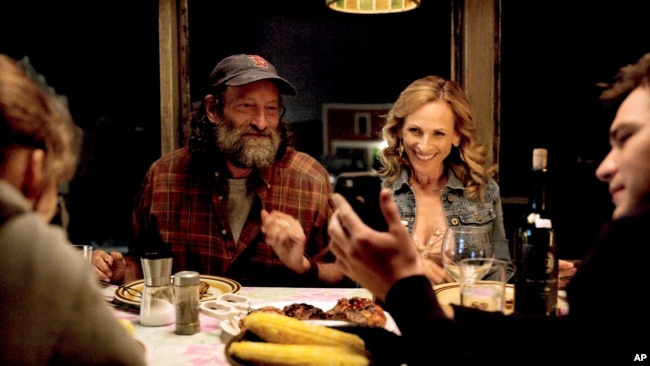
Troy Kotsur, nominated for an Oscar for best supporting actor for his role in the film “CODA,” poses for a photo at Red Rock Park in Mesa, Ariz., on Jan. 28, 2022. (AP Photo/Matt York)
Troy Kotsur is the second deaf actor to be nominated for an Academy Award. In his Oscar-nominated performance in CODA, Kotsur spoke just one word.
CODA stands for Child Of Deaf Adults. The movie stars Emilia Jones as the only hearing member of a deaf family. Urging Jones, his daughter, to go after her dreams of singing and attending college, Kotsur says: “Go!”
For Kotsur, that one word meant lots of rehearsal. It also meant speaking dialogue he himself could not hear.
“I hope that young people who happen to be deaf or hard of hearing can get an increased confidence,” Kotsur said. “I want those kids to not feel limited.”
The Apple TV+ release CODA, is nominated for Best Picture. The movie has made Kotsur famous and made history for the deaf community. Kotsur is the first deaf actor ever nominated individually for a Screen Actors Guild award. He was also nominated for a BAFTA.
“I feel like I can die happy, with a smile on my face,” Kotsur said.
Kotsur’s road to the Oscars began in school. As a child, Kotsur loved cartoons like Tom and Jerry. He would act out the stories for his deaf classmates on the school bus. He later studied acting at Gallaudet University, a university for the deaf in Washington, D.C. He later performed with the National Theatre of the Deaf.
With few roles in television and film available for deaf actors, Kotsur found work in stage acting. Beginning with Of Mice and Men in 1994, Kotsur has acted in some 20 productions by Deaf West. Deaf West is a nonprofit theater company in Los Angeles.
On stage, Kotsur is a very physical actor. “It’s really important for me on stage to show emotion through sign language,” Kotsur said. “Sometimes, sign language can be more three-dimensional and meaningful than spoken dialogue.”

Kotsur has long been used to seeing simple, if not victimized, deaf characters. But the deaf characters of CODA are presented differently. The Rossi family in the movie are a family like any other.
Kotsur wants viewers to change their wrong ideas about what deaf people are like. “There are deaf doctors. There are deaf lawyers. There are deaf firemen. A lot of hearing people are oblivious to that,” he said.
Perhaps Kotsur’s most emotional scene is shared with his daughter, Ruby. Unable to hear Ruby’s singing, he listens to her sing by feeling the vibrations of her neck. The scene has connections to Kotsur’s own life. His daughter is also the child of deaf adults who plays music.
“When my daughter is playing music … I’ll walk up and I’ll touch the body of the acoustic guitar and I can feel the vibrations of the guitar,” Kotsur said.
The first time Kotsur read the script for CODA, he took it as a warning sign. He, like his character, is not ready for his daughter to leave home. It is these personal connections that have made it hard for the actor to separate from the character Frank.
“It took me about half a year to disconnect from Frank,” he said.
Kotsur has since gone on to appear in the Disney+ series “The Mandalorian.”
DJ Kurs is the director of Deaf West. He said Kotsur “is one of the greats.”
“We’ve been waiting for the world to recognize it for some time now and it is our hope that … future deaf actors will not have to wait so long to be recognized on this level.”
I’m Dan Novak.
Dan Novak adapted this for VOA Learning English from reporting by The Associated Press.
_______________________________________________________________
Words in This Story
rehearsal — n. an event at which a person or group practices an activity
dialogue — n. the things that are said by the characters in a story, movie, play, etc.
role — n. the character played by an actor
dimension — n. the amount or number of things that something affects or influences
oblivious — adj. not conscious or aware of someone or something
vibration — n. a continuous slight shaking movement
acoustic — adj. not having its sound changed by electrical devices